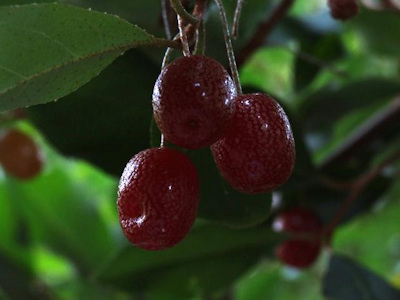|
Goumi like Autumn Olives are a species of Elaeagnus native
to China, Korea, and Japan. Elaeagnus multiflora is a deciduous or
semi-evergreen shrub or small tree growing to 2-8 m tall, with a trunk up to 30
cm diameter with dark brown bark.
Goumi are high in vitamin A and E, bioactive compounds,
minerals, flavonoids and proteins. Their lycopene content is the highest of any
food and is being used in the prevention of heart disease, cancers and in the
treatment of cancer. Cooking the fruit increases the lycopene content. The
fruits and seeds are an excellent source of essential fatty acids as well which
is very unusual for a fruit. The seeds are also edible although somewhat fibrous,
and are especially high in proteins and fats.
The fruit is round to oval drupe 1 cm long, silvery-scaled
orange, ripening red dotted with silver or brown, pendulous on a 2-3 cm
peduncle. When ripe in mid- to late summer, the fruit is juicy, tart and
edible.
All of the eleagnus species are nitrogen fixers. They take
nitrogen out of the air and put it into the ground through a symbiotic
relationship with a bacteria that lives in their roots, thereby improving the
fertility of the surrounding soils.
Future database has some good things to say about the Goumi.
As well as confirming the health benefits and edible nature (pleasantly acid
flavour), it is noted that plants can be grown as a hedge in exposed positions,
tolerating maritime exposure. Reasonably fast growing and providing a good
screen in the summer, though much more open in the winter. It is a good
companion hedge to grow, the plants enriching the soil and improving the growth
of neighbouring plants.
Goumi Distribution
This tree is indigenous to China, Korea and Japan. It is
also grown in various parts of North America and Europe. This species has
become naturalized in different regions of eastern United States.
|

